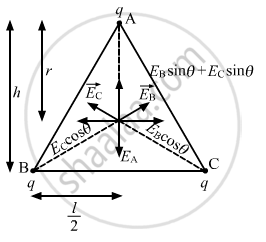Advertisements
Advertisements
प्रश्न
Three identical charges, each with a value of 1.0 × 10−8 C, are placed at the corners of an equilateral triangle of side 20 cm. Find the electric field and potential at the centre of the triangle.
उत्तर
Given:
Magnitude of charges, q = 1.0 × 10−8 C
Side of the triangle,
l = 20 cm = 0.2 m

Let \[E_A , E_B \text{ and } E_C\] be the electric fields at the centre due to the charges at A, B and C, respectively.
The distance of the centre is the same from all the charges. So,
\[E_{net} = E_A - \left( E_B \sin\theta + E_A \sin\theta \right)\]
\[ = E\left( 1 - \sin30^\circ- \sin30^\circ \right)\]
\[ \Rightarrow E_{net} = 0\]
Now,
\[h^2 = l^2 - \left( \frac{l}{2} \right)^2 \]
\[ h^2 = \left( 0 . 2 \right)^2 - \left( 0 . 1 \right)^2 \]
\[ \Rightarrow h = \frac{\sqrt{3}}{10}\]
Let the distance of the centre from each charge be r.
For an equilateral triangle,
\[r = \frac{2}{3}h\]
\[ \Rightarrow r = \frac{2}{3} \times \frac{1 . 732}{10} = 1 . 15 \times {10}^{- 1} \] m
Potential at the centre,
\[V = V_A + V_B + V_C \]
\[ \because V_A = V_B = V_{C,} \]
\[ V = 3 V_A\]
\[V = 3 \times \frac{1}{4\pi \epsilon_0}\frac{q}{r}\]
\[V = \frac{3 \times 9 \times {10}^9 \times {10}^{- 8}}{0 . 115}\]
APPEARS IN
संबंधित प्रश्न
The electrostatic force on a small sphere of charge 0.4 μC due to another small sphere of charge − 0.8 μC in air is 0.2 N.
- What is the distance between the two spheres?
- What is the force on the second sphere due to the first?
- Two insulated charged copper spheres A and B have their centers separated by a distance of 50 cm. What is the mutual force of electrostatic repulsion if the charge on each is 6.5 × 10−7 C? The radii of A and B are negligible compared to the distance of separation.
- What is the force of repulsion if each sphere is charged double the above amount, and the distance between them is halved?
Four charges +q, −q, +q and −q are to be arranged respectively at the four corners of a square ABCD of side 'a'.
(a) Find the work required to put together this arrangement.
(b) A charge q0 is brought to the centre of the square, the four charges being held fixed. How much extra work is needed to do this ?
Plot a graph showing the variation of coulomb force (F) versus ,`(1/r^2)` where r is the distance between the two charges of each pair of charges: (1 μC, 2 μC) and (2 μC, − 3 μC). Interpret the graphs obtained.
A charge of 1.0 C is placed at the top of your college building and another equal charge at the top of your house. Take the separation between the two charges to be 2.0 km. Find the force exerted by the charges on each other. How many times your weight is this force?
Two charges 2.0 × 10−6 C and 1.0 × 10−6 C are placed at a separation of 10 cm. Where should a third charge be placed, such that it experiences no net force due to these charges?
Find the ratio of the electrical and gravitational forces between two protons.
Two particles A and B, each carrying a charge Q, are held fixed with a separation dbetween them. A particle C of mass m and charge q is kept at the middle point of the line AB. Under what conditions will the particle C execute simple harmonic motion if it is released after such a small displacement? Find the time period of the oscillations if these conditions are satisfied.
Two particles A and B possessing charges of +2.00 × 10−6 C and of −4.00 × 10−6 C, respectively, are held fixed at a separation of 20.0 cm. Locate the points (s) on the line AB, where (a) the electric field is zero (b) the electric potential is zero.
Two particles of masses 5.0 g each and opposite charges of +4.0 × 10−5 C and −4.0 × 10−5 C are released from rest with a separation of 1.0 m between them. Find the speeds of the particles when the separation is reduced to 50 cm.
Write a short note on superposition principle.
The electric force acting between two point charges kept at a certain distance in vacuum is 16 N. If the same two charges are kept at the same distance in a medium of dielectric constant 8, the electric force acting between them is ____________ N.
The unit of charge is ______.
SI unit of permittivity of free space is ______.
Two charge – 10c and + 10 c are placed 10 cm apart. Potential at centre of the line joining the two charge is:-
The capacity of an isolate conducting sphere of radius R is proportional to
Two charges q and – 3q are placed fixed on x-axis separated by distance ‘d’. Where should a third charge 2q be placed such that it will not experience any force?
Two point charges +2 C and +6 C repel each other with a force of 12 N. If a charge of -4 C is given to each of these charges, then the force now is ______.
What is meant by the statement: "Relative permittivity of water is 81"?
